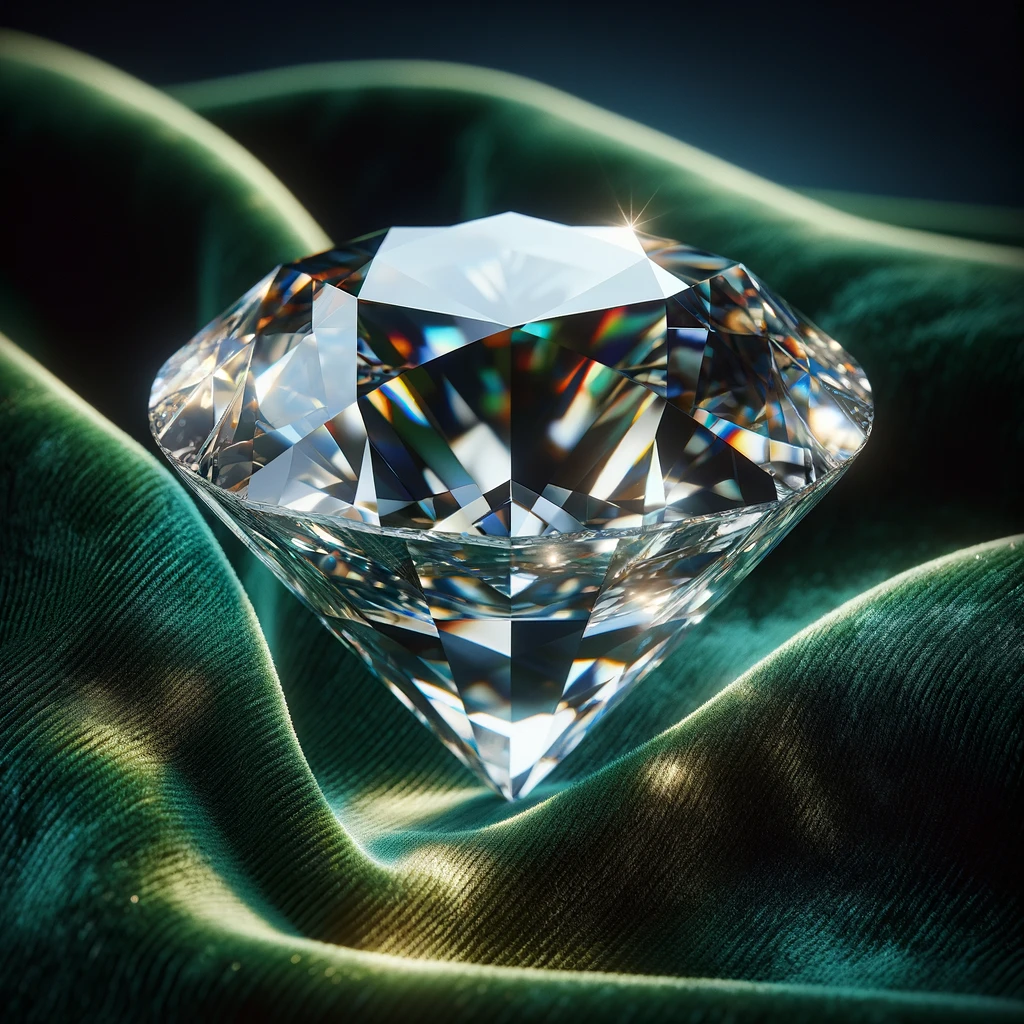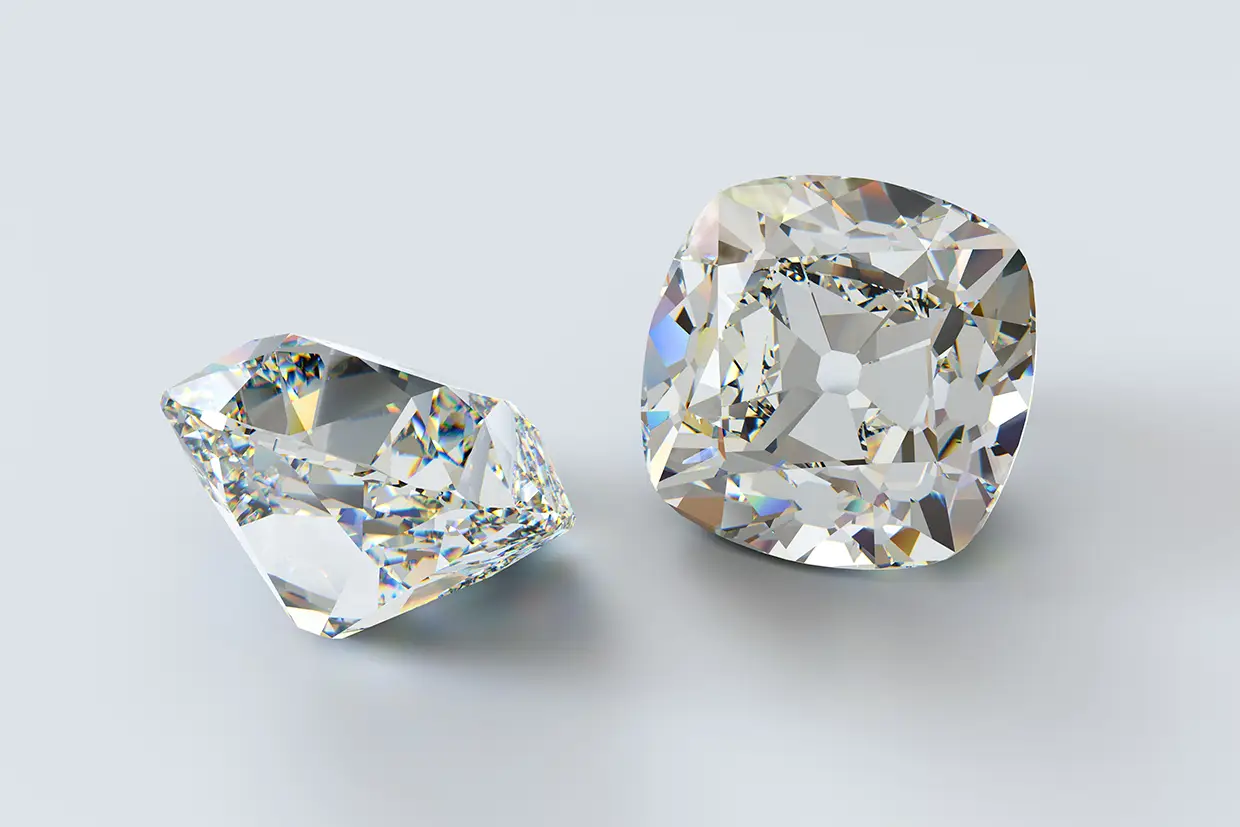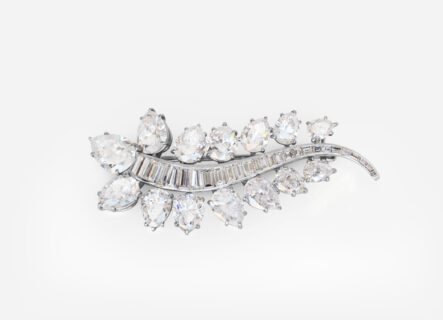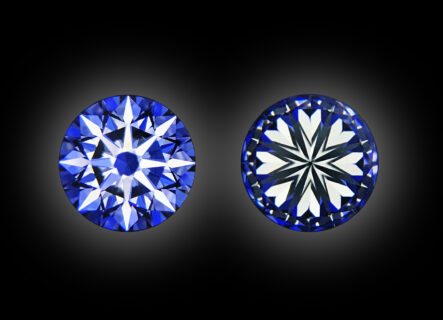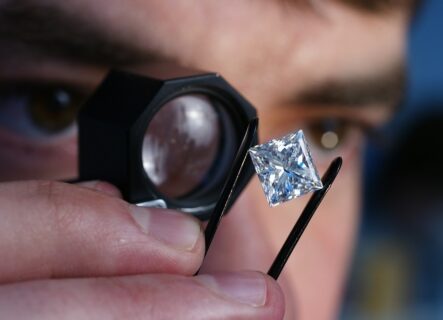Diamonds with antique mine cuts have a vintage appearance, giving the impression that they were taken directly out of your grandmother’s jewelry stash. They have a unique and striking look due to their vintage style. These diamonds bring back memories of an era when everything was done manually and there were no contemporary techniques of cutting precious stones.
They have undergone a revival, or more rather, a renewed interest and desire, in recent years. This antique diamond cut never fails to captivate with its handmade appeal and timeless charm.
What are the Old mine cut diamonds?
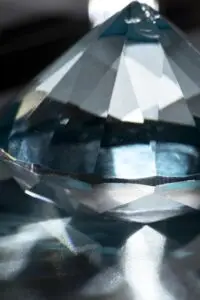
Old Mine Cut diamonds are a type of vintage diamonds that date back to when gemstones were cut and polished by hand. These antique diamonds have a truly lovely look.
They have a somewhat square shape with gentle rounded edges, quite similar to the cushion cut. Indeed, the Old Mine cut was the forerunner to the cushion cut. As such, this cut diamonds are akin to cushion cuts, but with an antique flair.
These stones are distinct for their broad facets that create unique brilliance, a noticeable culet, and distinctive proportions. Such diamonds are now undergoing a revival – many people are becoming increasingly drawn to the vintage aesthetic once more.
History of the Old mine cut diamonds
Diamonds cut in this style were prevalent during the 18th and 19th centuries when stones were cut and measured manually. These diamonds were commonly set in jewelry pieces of the Georgian, Victorian and Edwardian eras, with many rings from those periods featuring Old mine cut stones.
However, in 1919 the so-called diamond revolution occurred. Marcel Tolkowsky derived the mathematical formula for the modern round diamond known as the “ideal cut.” Stones cut according to this formula shone much brighter, looked more attractive, and had better symmetry. For a time, the fashion for this cut waned, only to return again hundred years later.
The name “old mine” refers to diamonds that are sourced from older mines in Brazil and India rather than new discoveries in South Africa. An intriguing backstory surrounds the name of this cut. Until the late 19th century, the majority of diamonds were found in mines in Brazil and India. However, during the 1860s, more diamond discoveries were made in South Africa, sparking a boom in the continent’s diamond mining industry.
What traits do old mine cut diamonds have visually?
Although they share certain similarities with present cut diamonds, old mine cut diamonds have distinctive attributes that set them apart from more recent cuts. Examining these distinctive features in greater detail helps to clarify what makes ancient mine cuts special small table the table.
Small table
The table facet on these cuts is noticeably smaller in comparison with round brilliant and cushion cuts. This is evident when viewing the precious stone from above.
Noticeable culet
A large culet facet is a trademark of these cuts, clearly visible when looking down through the top of the stone.
High crown & deep pavilion
In contrast to other diamond cuts, old mine cuts often have a lofty crown and a deep pavilion.
58 facets
With 58 total facets, including a sizable culet, the cut has more facets than modern diamond cuts..
Unbalanced symmetry
These precious stones exhibit uneven and imprecise facets, a result of hand-cutting methods used at the time. This gives them an asymmetrical appearance.
Interestingly, these cuts were designed to be viewed in candlelight, unlike today’s diamonds meant for bright lighting. Consequently, they have a softer, larger, more romantic glow.
The Old mine cut diamonds value
Similar to other contemporary cut diamonds, the cost of such gems is determined by a number of variables, including the 4Cs: carat weight, color, clarity, and cut. But such cut diamonds were worth ten to fifteen percent less than modern cut diamonds for a very long time. For example, a 2 carat old mine cut diamond of good grade might be had for more than $5,000.
Old mine cut diamonds and other ancient gems were sold for marginally less than contemporary cut stones until recently. This is because to the fact that they were regularly recut into contemporary shapes, which caused some of the original diamond substance to be lost.
Still, these diamonds have a special appeal now due to their unusual appearance. Consequently, the price of these diamonds is often the same as that of contemporary cut diamonds of similar quality.
Furthermore, an Old mine cut diamond might even fetch more money than other diamonds of a similar quality if it has historical or cultural value.
World famous Old mine cut diamonds
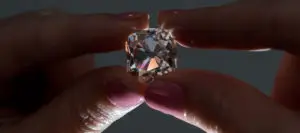
For more than two centuries, the magnificent 19.07 carat pink diamond known as Le Grand Mazarin Diamond has adorned the crowns of French kings and queens.
The Regent Diamond is a famous colorless diamond that was mined in the 17th century. In its uncut form, it weighed 426 carats, but was later fashioned into a 140.63 carat gem.
The Cullinan II is a 317 carat diamond that is part of the Imperial State Crown of the British Monarchy.
The Wittelsbach Diamond is a 35.56 carat historic blue diamond.
Old European cut vs Old mine cut
References to the Old European cut gem can be found when examining the Old mine cut diamond. Every now and then, people compare these two diamond cuts to one another. There are significant distinctions between them even though they have certain things in common.
Age: The Old European cut was made more than a century before the Old Mine Cut.
Shape:The Old European cut is more like the round brilliant cut, while the Old Mine cut is more like the contemporary cushion cut.
Culet: The Old Mine Cut’s culet is usually significantly larger and visible through the table with the unaided eye.
Proportions: The Old European cut is slightly deeper than the Old Mine cut.
Fire: In terms of how they reflect light and create color contrast, the Old Mine Cut and the Old European Cut have differing optical performances.
Conclusion
Locating original old mine cut diamonds can be more difficult than locating modern gemstones because they are not created anymore. Their restricted availability is the crucial element.
This may seem unusual, but the certificate and information included within are not nearly as vital for old mine cut diamonds as they are for up-to-date diamonds. These gems are unsatisfactory as high-quality fashion-shaped diamonds due to their asymmetry, imperfections, and other characteristics. But this is not the main factor to take into account when buying antique stones. Prioritizing your unique preferences and the appeal of these pearls for you is preferable.
Subscribe to discover the world of diamonds and gems. If you have any questions, please let us know.


